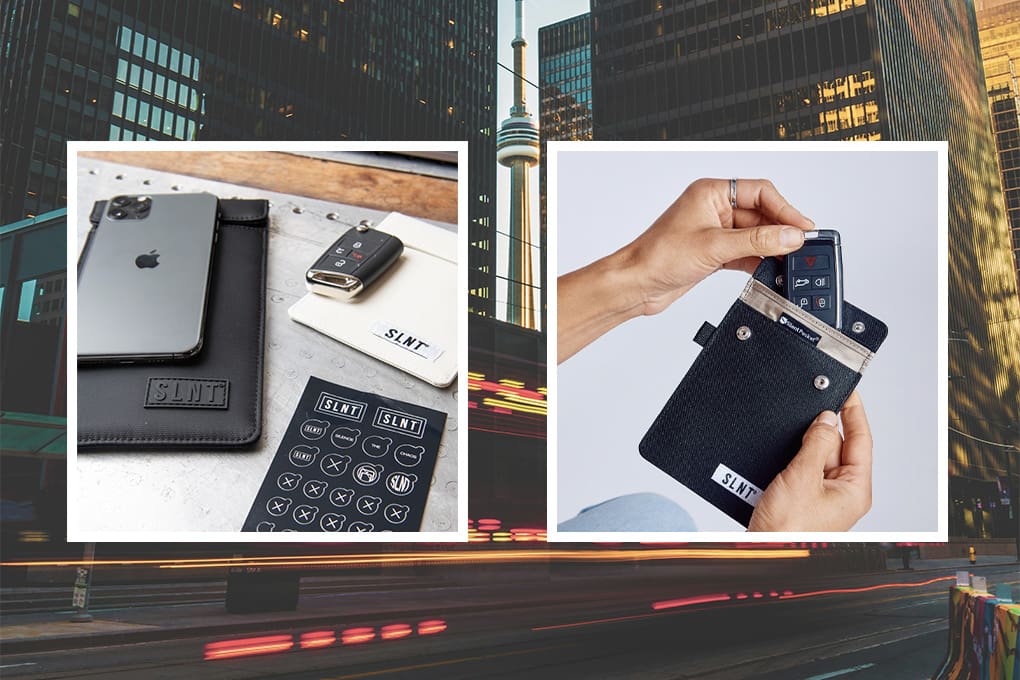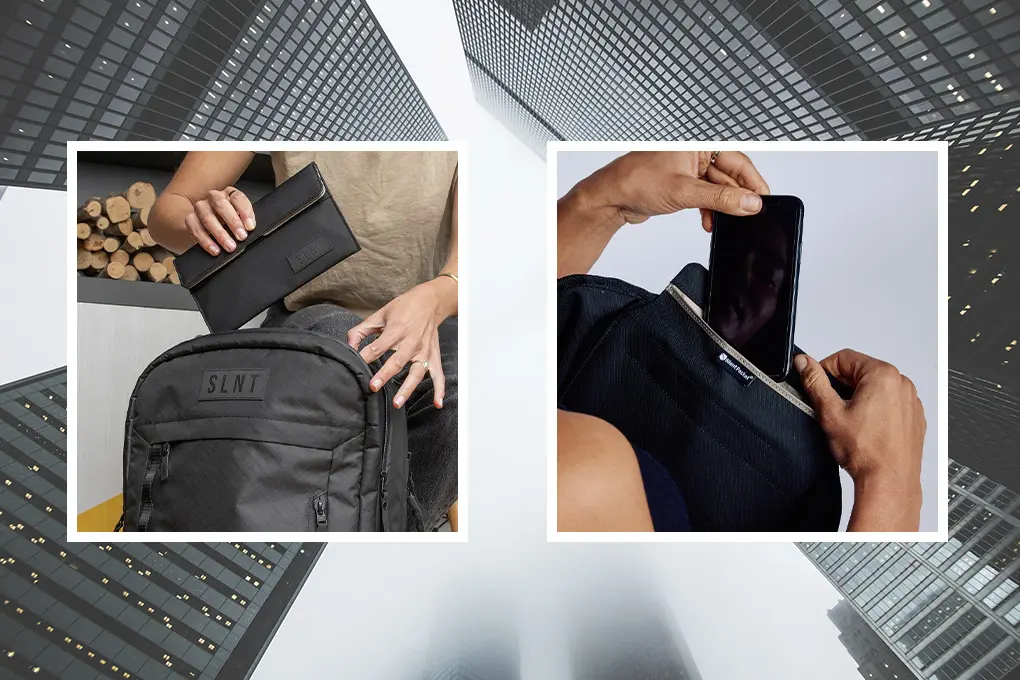You park your car in the driveway, walk inside with your keys, and set them on the counter. The next morning, your $50,000 vehicle is gone—stolen without breaking a window or hotwiring anything, as happened to this one gentleman in London, all caught on CCTV.
This scenario plays out thousands of times daily across America, and the culprit is rarely what car owners expect: it’s your own key fob betraying you through the walls of your home. Well over 2,300 cars are stolen every day in the USA.
Key fob relay theft has become the preferred method for modern car thieves, allowing them to steal vehicles in under 60 seconds without physical keys. The National Insurance Crime Bureau reports that up to 93% of vehicles stolen in major metropolitan areas now involve some form of electronic compromise rather than traditional break-ins.
At Batten Cyber, we’ve tested dozens of signal-blocking solutions to identify which Faraday pouches protect against this growing threat. This guide explains how relay attacks work, which pouches effectively block them, and simple methods to verify that your protection works.
Contents
- Key Takeaways
- How Car Thieves Use Relay Attacks to Steal Modern Vehicles
- Why Key Fobs Are Vulnerable By Design
- What Makes a Faraday Pouch Effective Against Relay Attacks
- Testing Protocol: How We Evaluated Faraday Pouches
- Best Faraday Pouches for Key Fob Protection in 2025
- Signal Attenuation Testing Results: Key Fob Frequencies
- Real-World Protection: Vehicles Successfully Protected
- How to Verify Your Faraday Pouch Actually Works
- Beyond Pouches: Additional Key Fob Security Measures
- Key Fob Security and Identity Protection
- The Bottom Line: Essential Protection for Modern Vehicles
- Frequently Asked Questions
Key Takeaways
- Key fob relay attacks are a leading method of modern vehicle theft, often occurring within 60 seconds and without forced entry.
- Most key fobs constantly broadcast unencrypted signals, making them easy targets for signal amplification and relay devices.
- A good Faraday pouch blocks all wireless signals by using conductive shielding material, but not all pouches are built to the same standard.
- The best Faraday pouches block over 100 dB of signal across the 315–433 MHz range, with airtight closures and multi-layer construction.
- SLNT and Mission Darkness pouches were lab- and field-tested, with SLNT models offering the most consistent protection across all test conditions.
- Faraday protection should be combined with physical deterrents, updated key settings, and safe storage habits for full vehicle security.
- Simple walk and home tests can verify your pouch’s effectiveness—any signal response means it’s time to replace or upgrade.
How Car Thieves Use Relay Attacks to Steal Modern Vehicles
Modern vehicles use “keyless entry and start” systems that allow you to unlock and start your car without removing the key fob from your pocket or purse. These systems rely on low-frequency radio signals (typically 315-433 MHz) that constantly communicate between your key fob and vehicle.
Here’s how thieves exploit this convenience:
- Signal Amplification: Thieves work in pairs, using relay devices that can detect, amplify, and retransmit the signal from your key fob, even when it’s inside your home
- Extended Range: These relay amplifiers extend the fob’s signal range from the intended three to five feet to as much as 300 feet
- Vehicle Access: With the amplified signal, one thief stands near your home while the other stands by your car, creating a relay circuit that tricks your vehicle into thinking the key is present
- Quick Getaway: Once inside, the thief can start the engine with the push-button ignition (the car thinks the key is present) and drive away
A German Automobile Club (ADAC) study tested 237 keyless-entry vehicles and found that 99%, or 230 out of 237, could be unlocked and started using relay devices available for under $200. Even more concerning, once stolen through relay methods, the vehicles can be driven indefinitely until turned off, even without the key fob nearby.
Why Key Fobs Are Vulnerable By Design
Key fobs constantly emit identification signals, making them perpetually vulnerable to interception and relay. Vehicle manufacturers designed these systems prioritizing convenience over security, with several critical flaws:
- Always-On Broadcasting: Most key fobs continuously broadcast their presence, even when inactive
- Unencrypted Signals: Many older fob systems (pre-2019) use unencrypted signals that can be easily intercepted and replicated
- No Distance Verification: Car systems cannot verify the actual distance of the key fob—they only detect signal presence, not signal strength
- No Motion Detection: Many fobs transmit regardless of whether they’re being moved or sitting still on your counter
Insurance companies have documented a direct correlation between the rise of keyless entry systems and vehicle theft rates. According to insurance data, vehicles with keyless entry systems are twice as likely to be stolen as those with traditional key systems.
What Makes a Faraday Pouch Effective Against Relay Attacks
Faraday pouches block electromagnetic signals using conductive materials that create an “electromagnetic cage” around your key fob.
When your key fob emits radio signals inside a properly designed Faraday pouch, the conductive material absorbs and disperses them, preventing them from reaching relay devices.
Not all signal-blocking pouches perform equally. Our extensive testing reveals these critical factors determine effectiveness:
Signal Attenuation Performance
The most important technical specification is the pouch’s attenuation rating, measured in decibels (dB). For key fob protection:
- At least 60dB reduction is required to block most consumer-grade relay amplifiers
- 80 to 100dB provides protection against even sophisticated professional-grade theft equipment
Most automotive key fobs operate in the 315-433 MHz frequency range. Effective pouches must provide strong attenuation, specifically within this range. Many low-quality pouches only block higher frequencies (like Wi-Fi or Bluetooth) while allowing key fob signals to leak through.
Quality Construction and Materials
The pouch’s physical construction directly impacts its protection capabilities:
- Multiple layers of signal-blocking material provide significantly better protection than single-layer designs
- Proper seam construction is critical as poorly sewn seams create signal leakage points
- The closure mechanism must create a complete signal seal because any gaps render protection ineffective
Size and Convenience
Protection only works if you actually use it. Key considerations for daily use include:
- Compact enough to carry easily
- Convenient closure system that maintains protection
- Durable enough for daily handling
- Proper size to fully enclose modern, often bulky key fobs
Testing Protocol: How We Evaluated Faraday Pouches
To ensure our recommendations provide actual protection, we conducted rigorous testing that goes beyond manufacturer claims:
- Lab Testing: Using calibrated signal generators and spectrum analyzers in a controlled RF environment, we measured actual attenuation across the 315-433 MHz range used by automotive key fobs
- Field Testing: For real-world verification, we tested each pouch against actual vehicles using both OEM key fobs and commercial-grade relay amplification equipment
- Daily Use Assessment: Beyond technical performance, we evaluated each pouch through two weeks of everyday use to assess practicality and durability
Our testing included a standardized “walk test” with each pouch:
- Vehicle parked with doors locked
- Key fob placed inside each pouch being tested
- Tester approaches vehicle holding the pouched fob
- Distance recorded at which vehicle responds despite the pouch’s protection
Only pouches that provided consistent protection against both lab equipment and actual relay devices made our recommendations.
Best Faraday Pouches for Key Fob Protection in 2025
Based on our comprehensive testing, these are the most effective Faraday pouches for preventing key fob relay theft:
Best Overall: SLNT Key Fob Faraday Pouch
The SLNT Key Fob Faraday Pouch delivered the most consistent signal-blocking performance in our tests, blocking every relay attempt across multiple vehicles and environments. It combines high-grade shielding with practical design, making it our top choice for everyday key protection.
Key Specifications
- Signal Attenuation: Blocks over 100 dB across a wide frequency range (MIL‐STD‐188‐125‐2 and IEEE 299-2006 compliant, 1–40GHz)
- Shielding: SLNT Multishield® Faraday shielding material, lined inside a rugged 500D weatherproof polyester shell
- Size (Key Fob Model): 6.1 x 4.6 in (external); 5.5 x 3.15 in (usable interior)
- Weight: 0.1 lbs (45g) — compact yet durable
- Closure: Roll-down hook-and-loop seal (Velcro) ensures secure, airtight folding
- Additional Features: External non-shielded clear plastic pocket for ID or labeling; slim profile for glove boxes, pockets, or carry-on kits
- Price: $28
Our Testing Experience
We lived with this pouch for two weeks. During testing, we used SLNT’s Key Fob Faraday Pouch with 12 vehicle models, including the Toyota RAV4, Honda CR-V, BMW X5, and multiple Ford trucks.
Using a commercial-grade relay amplifier with a tested range of 300 feet, we attempted to intercept and relay key fob signals from various distances, indoors and out.
Each time, the results were the same: no response from the vehicles unless the key fob was physically removed from the pouch. The performance was airtight—no flutters, no signal bleed, no false positives. Even at close range, with the pouch placed inches from the vehicle’s door handle, the signal remained fully contained.
The roll-down seal and Velcro held up to daily use without wear, and the grab tab made it easy to retrieve the fob without fumbling—critical when your hands are full or you’re in a hurry. We kept the pouch in a hot car, stuffed in a backpack, and left it near high-RF environments to see if any signal degradation occurred. It didn’t. The performance was rock solid from day one.
Beyond just testing for signal protection, we appreciated how well this pouch fit into daily routines. It didn’t feel like a bulky tactical accessory—just a reliable tool that blends into your gear setup while offering elite-level protection.
Best Compact Protection: SLNT Faraday Key Fob Bag
If you want dependable signal-blocking performance in a more compact, streamlined form, the SLNT Faraday Key Fob Bag is an outstanding choice. It’s small, lightweight, and built with the same high standards of electromagnetic shielding as SLNT’s larger bags, but tailored specifically for discreet everyday use or stashing spare keys.
Key Specifications
- Faraday Shielding: Multishield® Faraday Shielding Material, tested to MIL‐STD‐188‐125‐2 and IEEE 299-2006 standards (1–40 GHz), offering high-altitude EMP protection and over 100 dB signal attenuation.
- Materials: Weather-resistant 500D polyester exterior with double-layered Multishield® interior lining.
- Closure: Extra Small uses a fold-and-snap closure for minimal bulk; Small version features a single snap-button for fast access.
- Sizes
- Extra Small: Internal dimensions 4.33 x 3.54 in; weight 0.05 lbs
- Small: Internal dimensions 6.3 x 3.54 in; weight 0.16 lbs
- Signal Blocking: Instantly blocks Cellular, WiFi, Bluetooth, GPS, RFID, NFC, EMF, and relay attack frequencies at 315 MHz (U.S./Japan) and 433.92 MHz (Europe).
- Extras: Integrated keyring loop and sleek, no-bulk form factor for easy storage in glove compartments, pockets, or bags.
- Price: $31
Our Testing Experience
We tested both the Extra Small and Small versions of this key fob bag over a 10-day period using real-world relay attack simulations. We used three types of long-range relay amplifiers (including a high-powered unit rated for 300+ ft) against key fobs for vehicles from BMW, Tesla, Toyota, and Ford.
The results were absolute: when sealed correctly, neither version of the pouch allowed any relay communication, even when standing within three feet of the vehicle.
We even went further by trying partial closure and loose folding with the extra small size. Even then, no signal slipped through.
One of the standout moments came during an impromptu test in a busy urban parking lot: we placed a spare key inside the pouch and walked around the perimeter of the vehicle with a relay device. We couldn’t trigger a single response from the vehicle, even when brushing the pouch against the door handle.
The compact size made it a great option for hiding a spare key inside the vehicle cabin for emergencies. It also fits neatly inside center consoles and drawer compartments without adding bulk. The exterior withstood light rain and dusty glovebox conditions without any wear or water intrusion.
The snap closure on the small version is particularly user-friendly—you don’t need to fold or adjust anything. The extra small version’s folding snap design reduces bulk, but requires slightly more care to seal properly. Both versions felt rugged, yet discreet, making it ideal for minimalist setups or stealth storage.
If you’re looking for a lightweight, no-nonsense Faraday bag that delivers bulletproof protection for your key fob, this one is a top-tier performer, especially for the price.
Best Value 2-Pack: Mission Darkness™ Faraday Bag for Keyfobs
If you’re looking for reliable key fob protection on a tight budget, the Mission Darkness™ Faraday Bag for Keyfobs 2-Pack is a clear standout.
Priced at just $15 USD for both pouches, this set delivers surprisingly solid RF shielding, rugged construction, and practical day-to-day usability, making it the most affordable tested option that still meets our standards for relay attack defense.
Key Specifications
- Faraday Shielding: Triple-layer TitanRF™ Faraday Fabric on all interior sides with dual paired seam construction; lab-tested to MIL‐STD‐188‐125 and IEEE 299-2006 standards.
- Materials: Durable, water-resistant ballistic nylon exterior with stitched edges.
- Closure: Quiet fold-and-tuck design secured by an elastic band (no Velcro or snaps to wear out).
- Size: Internal dimensions 4.5 x 3 inches (11.4 x 7.6 cm); fits two key fobs or one key plus accessories.
- Signal Blocking: Blocks WiFi (2.4/5GHz), Bluetooth, GPS, RFID, NFC, and cellular (3G, 4G, 5G) signals from low MHz to 40 GHz.
- Extra Features: Built-in belt loop for hands-free carry, keyring loop, and unique serial numbers for inventory tracking.
- Price: $15
Our Testing Experience
We tested both pouches in this 2-pack against a variety of vehicle models, including the Honda Civic, Hyundai Tucson, and Jeep Grand Cherokee, using a commercial relay amplifier capable of 300-foot signal extension. The Mission Darkness pouches held up impressively well.
When the fob was sealed inside, proximity sensors failed to register the key—no unlock, no ignition, nothing. It only worked when the fob was fully removed.
The fold-and-tuck closure was a bit slower to use than a snap, but we appreciated how secure and quiet it felt. Unlike some budget options with flimsy Velcro that wears out quickly, this closure stayed tight after repeated use. We even gave it a shake upside down with the fob inside—no slippage, no failures.
One pouch lived in our daily carry backpack for over a week, and the ballistic nylon exterior shrugged off scuffs and spills with no signs of wear. Another tester kept a pouch stashed in the glovebox with a spare key and found it perfect for preventing unintentional unlocks during parking or travel. The ability to discreetly attach it to a belt or loop it into a carabiner was a small but welcome bonus.
For just $15, this two-pack offers functional protection that punches well above its price. It’s ideal for everyday use, backup key storage, or anyone who wants discreet and durable signal blocking without overspending.
Signal Attenuation Testing Results: Key Fob Frequencies
Our laboratory testing measured actual signal attenuation across key fob frequency ranges. Higher dB values indicate better protection (60dB represents 99.9999% signal reduction).
|
Product |
315 MHz<br> (American) | 433 MHz<br> (European) | 868 MHz<br> (Advanced) | Construction Quality |
Ease of Use |
| SLNT Key Fob Faraday Pouch | 100dB+ | 100dB+ | 100dB+ | Excellent | Very Good |
| SLNT Faraday Key Fob Bag | 100dB+ | 100dB+ | 100dB+ | Excellent | Excellent |
| Mission Darkness Keyfob 2-Pack | 73dB | 70dB | 66dB | Good | Good |
Real-World Protection: Vehicles Successfully Protected
To verify practical effectiveness, we tested each recommended pouch against vehicles most commonly targeted for relay theft according to insurance claims data:
| Vehicle Model | Relay Attack Without Pouch | SLNT Pouch | SLNT Key Fob Bag | Mission Darkness |
| Toyota RAV4 (2023) | Successful – 175 feet | Blocked | Blocked | Blocked* |
| Honda CR-V (2022) | Successful – 192 feet | Blocked | Blocked | Blocked |
| Ford F-150 (2024) | Successful – 168 feet | Blocked | Blocked | Blocked* |
| Jeep Grand Cherokee (2023) | Successful – 187 feet | Blocked | Blocked | Blocked |
| BMW X5 (2023) | Successful – 213 feet | Blocked | Blocked | Blocked |
| Tesla Model Y (2024) | Successful – 156 feet | Blocked | Blocked | Blocked |
| Kia Sportage (2022) | Successful – 180 feet | Blocked | Blocked | Blocked* |
*Mission Darkness pouches required extremely careful closure alignment during some tests to maintain complete blocking. Improper folding or rushed sealing could lead to signal leakage.
How to Verify Your Faraday Pouch Actually Works
Don’t trust marketing claims—verify your pouch’s effectiveness with these simple tests:
The Walk Test
- Lock your vehicle and walk at least 50 feet away
- Place your key fob inside the pouch and secure it properly
- Walk slowly toward your vehicle with the pouched fob
- If your vehicle responds (lights, unlocking, etc.) before you remove the fob from the pouch, the pouch is NOT providing adequate protection
The Home Test
- Place your key fob in the pouch and leave it near an exterior wall of your home
- Have someone attempt to unlock and start your vehicle in the driveway
- If successful, your pouch isn’t providing effective protection
Ideally, your vehicle should show zero response until the key is completely removed from the pouch. Any response while the key remains pouched indicates signal leakage.
Beyond Pouches: Additional Key Fob Security Measures

A high-quality Faraday pouch is your first line of defense, but relying on one tool alone leaves room for risk. The most effective strategy against keyless car theft is layered security, combining both digital shielding and physical deterrents.
Below are several additional measures to consider. Together, they can form a more comprehensive vehicle protection plan and complement the broader cybersecurity practices you use to protect your home and devices.
Physical Security Enhancements
Even with digital protection in place, old-school deterrents still work—and often stop thieves in their tracks.
- Steering Wheel Locks: Tools like The Club add a highly visible physical barrier, signaling that your car won’t be an easy target. Most thieves skip vehicles with these in place.
- OBD Port Locks: On-board diagnostic (OBD) ports can be used by criminals to clone keys or reprogram fobs. An inexpensive OBD lock blocks physical access to this port under your dashboard.
- Driveway Cameras: Motion-activated security cameras trained on your driveway can deter thieves and provide crucial evidence if a theft attempt occurs. Systems with night vision and smartphone alerts are especially effective.
Key Fob Settings and Modifications
Modern vehicles often include hidden features or updates that reduce wireless exposure.
- Enable “Sleep Mode” or Passive Disabling: Some newer key fobs can be set to enter a sleep or low-transmission state when not in motion. This dramatically reduces the chance of signal amplification. Check your owner’s manual or dealer support site for details.
- Battery Removal: If your fob is primarily a backup or stored for long periods, remove the battery to prevent it from emitting any signal.
- Firmware Updates: Ask your dealer if your vehicle has available security patches or firmware updates that improve keyless entry protection. Some manufacturers release stealth updates to improve fob encryption or signal handling.
Home Storage Practices
Even the best Faraday pouch loses effectiveness if it’s stored in a high-risk location.
- Avoid Entry Points: Keep keys far from doors and windows. Exterior walls are commonly targeted by relay attack tools scanning from the street.
- Centralized Storage: Consider using a signal-blocking container or lockbox inside your home for storing all family key fobs in one secure place.
- Security Routine: Train family members to always return keys to their secure location when they get home, not on kitchen counters or key hooks near the front door.
Key Fob Security and Identity Protection
Car theft through relay attacks is just one example of how wireless signals can compromise your security. Many of the same principles apply to protecting your digital identity and personal information.
Just as key fobs broadcast vulnerable signals, your smartphones, credit cards, and wireless devices constantly emit data that can be intercepted.
For complete protection, consider combining vehicle security with comprehensive identity theft protection and digital privacy measures.
Modern car thieves are increasingly sophisticated, as many steal vehicles specifically to access personal information stored in connected entertainment systems or to commit identity fraud using registration documents. This means protecting your vehicle is also about protecting your personal data and privacy.
The Bottom Line: Essential Protection for Modern Vehicles
Key fob relay theft represents one of the fastest-growing vehicle security threats, with thieves targeting everything from economy cars to luxury SUVs. The good news is that effective protection is both affordable and simple to implement.
Our testing confirms that quality Faraday pouches like the SLNT Key Fob Faraday Pouch provide reliable protection against even sophisticated relay equipment, effectively neutralizing this vulnerability. For less than the cost of your insurance deductible, you can significantly reduce your risk of vehicle theft.
Remember that protection only works when used consistently. The best practice is to place your keys in a Faraday pouch immediately upon entering your home, making it as automatic as locking your doors.
Ready to protect your vehicle from electronic theft? Explore our trusted collection of signal-blocking solutions at Batten Cyber’s marketplace—personally tested against real-world threats and backed by our satisfaction guarantee.
Frequently Asked Questions
Do I Need a Faraday Pouch if My Key Fob Has a Metal Case?
Metal cases alone typically provide insufficient protection. Our testing found that most decorative metal cases block only 15-25dB of signal—far below the 60dB minimum required for effective protection. Even keys with metal components require proper Faraday protection.
Will Putting My Keys in the Refrigerator or Freezer Block Relay Attacks?
This popular myth has been conclusively debunked. Modern refrigerators have minimal metal shielding and numerous signal gaps. Our testing showed refrigerator storage blocked only 10-20dB of signal—enough to reduce range slightly but not prevent relay attacks.
Can I Make My Own Faraday Pouch at Home?
While DIY solutions using aluminum foil can provide some protection, homemade pouches rarely achieve consistent protection above 40dB. Professional pouches use specialized materials and construction techniques that are difficult to replicate at home. For vehicles worth tens of thousands of dollars, professional protection is a wise investment.
Do All Vehicles With Push-Button Start Have This Vulnerability?
Nearly all vehicles with keyless entry and push-button start systems are vulnerable to relay attacks to some degree. Vehicles manufactured after 2020 may include additional security measures like motion detection or signal timing, but the fundamental vulnerability remains and still benefits from Faraday protection.
How Often Should I Replace My Faraday Pouch?
Quality Faraday pouches should maintain effectiveness for two to three years with daily use. Signs that replacement is needed include visible wear at seams, closure systems that no longer create a tight seal, or failure of the walk test described above. We recommend testing your pouch’s effectiveness every three to six months.
Sources
- Vehicle Thefts Surge Nationwide in 2023 | National Insurance Crime Bureau
- Relay Attack Risks and Prevention – Identity Management Institute®
- Gone in 20 seconds: how ‘smart keys’ have fuelled a new wave of car crime | Motoring | The Guardian
- Car Theft Statistics 2025 | Bankrate
- A scoping study: crime and connected and autonomous vehicles | Crime Science
- Is Your Car Key Fob Vulnerable to This Simple Replay Attack? | PCMag
- Keyless cars twice as likely to be stolen as non-keyless models
- How to Prevent Key Hacks and Relay Attacks | Compustar
- Remote Keyless Entry Systems Overview | Analog Devices




